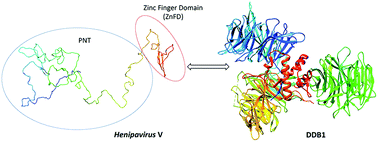当前位置:
X-MOL 学术
›
Mol. Biosyst.
›
论文详情
Our official English website, www.x-mol.net, welcomes your feedback! (Note: you will need to create a separate account there.)
The Henipavirus V protein is a prevalently unfolded protein with a zinc-finger domain involved in binding to DDB1
Molecular BioSystems Pub Date : 2017-09-26 00:00:00 , DOI: 10.1039/c7mb00488e Edoardo Salladini 1, 2, 3, 4, 5 , Vincent Delauzun 1, 2, 3, 4, 5 , Sonia Longhi 1, 2, 3, 4, 5
Molecular BioSystems Pub Date : 2017-09-26 00:00:00 , DOI: 10.1039/c7mb00488e Edoardo Salladini 1, 2, 3, 4, 5 , Vincent Delauzun 1, 2, 3, 4, 5 , Sonia Longhi 1, 2, 3, 4, 5
Affiliation

|
Henipaviruses are severe human pathogens within the Paramyxoviridae family. Beyond the P protein, the Henipavirus P gene also encodes the V protein which shares with P its N-terminal, intrinsically disordered region (PNT) and possesses a unique C-terminal domain predicted to be folded and to bind zinc (ZnFD). Henipavirus V proteins antagonize IFN signaling through PNT-mediated binding to STAT1, and several paramyxoviral V proteins promote STAT1 degradation through binding to DDB1. Structural and molecular information on Henipavirus V proteins is lacking, and their ability to interact with DDB1 has not been documented yet. We cloned the V genes from Nipah and Hendra viruses and purified the V proteins from E. coli and DDB1 from insect cells. Using analytical size-exclusion chromatography, CD and SAXS we characterized the V proteins and their domains. Using pull-down and MST we assessed their binding abilities towards DDB1. We show that PNT remains disordered also in the context of the V protein, while the ZnFD adopts a predominant β conformation. We also show that the V proteins interact with DDB1 predominantly via their ZnFD. This is the first experimental characterization of the Henipavirus V proteins and the first experimental evidence of their interaction with DDB1. The DDB1–ZnFD interaction constitutes a promising target for antiviral strategies. These studies provide a conceptual asset to design new antiviral strategies expected to reduce or abrogate the ability of these viruses to escape the innate immune response. They also contribute to illuminating the conformational behaviour of proteins encompassing large intrinsically disordered domains.
中文翻译:

所述亨尼帕V蛋白是一个普遍地折叠蛋白与参与结合DDB1一个锌指结构域
肝炎病毒是副粘病毒科中的严重人类病原体。除了P蛋白外,Henipavirus P基因还编码V蛋白,该蛋白与P共享其N端固有无序区(PNT),并具有一个独特的C端结构域,该结构域预计会折叠并与锌结合(ZnFD)。丙型肝炎病毒V蛋白通过PNT介导的与STAT1的结合来拮抗IFN信号传导,几种副粘病毒V蛋白通过与DDB1的结合促进STAT1的降解。缺乏有关肝炎病毒V蛋白的结构和分子信息,并且尚未证明它们与DDB1相互作用的能力。我们从Nipah和Hendra病毒中克隆了V基因,并从大肠杆菌中纯化了V蛋白。昆虫细胞中的DDB1。使用大小排阻色谱,CD和SAXS,我们对V蛋白及其结构域进行了表征。使用下拉和MST,我们评估了它们对DDB1的结合能力。我们显示,PNT在V蛋白的背景下仍然保持无序状态,而ZnFD采用主要的β构象。我们还显示,V蛋白主要通过其ZnFD与DDB1相互作用。这是肝炎病毒的第一个实验性表征V蛋白及其与DDB1相互作用的第一个实验证据。DDB1-ZnFD相互作用构成了抗病毒策略的有希望的目标。这些研究为设计新的抗病毒策略提供了概念上的资产,这些策略有望减少或消除这些病毒逃避先天免疫反应的能力。它们也有助于阐明包含大的内在无序域的蛋白质的构象行为。
更新日期:2017-10-25
中文翻译:

所述亨尼帕V蛋白是一个普遍地折叠蛋白与参与结合DDB1一个锌指结构域
肝炎病毒是副粘病毒科中的严重人类病原体。除了P蛋白外,Henipavirus P基因还编码V蛋白,该蛋白与P共享其N端固有无序区(PNT),并具有一个独特的C端结构域,该结构域预计会折叠并与锌结合(ZnFD)。丙型肝炎病毒V蛋白通过PNT介导的与STAT1的结合来拮抗IFN信号传导,几种副粘病毒V蛋白通过与DDB1的结合促进STAT1的降解。缺乏有关肝炎病毒V蛋白的结构和分子信息,并且尚未证明它们与DDB1相互作用的能力。我们从Nipah和Hendra病毒中克隆了V基因,并从大肠杆菌中纯化了V蛋白。昆虫细胞中的DDB1。使用大小排阻色谱,CD和SAXS,我们对V蛋白及其结构域进行了表征。使用下拉和MST,我们评估了它们对DDB1的结合能力。我们显示,PNT在V蛋白的背景下仍然保持无序状态,而ZnFD采用主要的β构象。我们还显示,V蛋白主要通过其ZnFD与DDB1相互作用。这是肝炎病毒的第一个实验性表征V蛋白及其与DDB1相互作用的第一个实验证据。DDB1-ZnFD相互作用构成了抗病毒策略的有希望的目标。这些研究为设计新的抗病毒策略提供了概念上的资产,这些策略有望减少或消除这些病毒逃避先天免疫反应的能力。它们也有助于阐明包含大的内在无序域的蛋白质的构象行为。


























 京公网安备 11010802027423号
京公网安备 11010802027423号